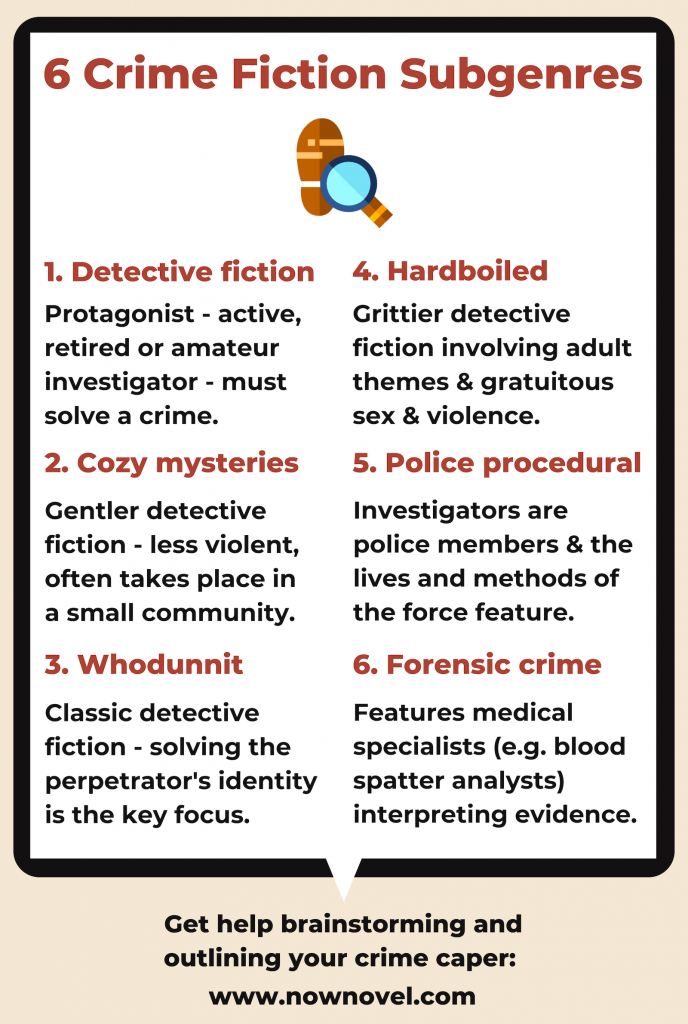Crime novels are full of surprising turns, hidden motives, human drama and tragedy. They give us the thrill of trying to figure out ‘whodunnit’. Or the pathos and interest of seeing how different characters respond to a tragic, intense situation. Here are tips for writing captivating crime novels:
First, what is crime fiction?
Broadly defined, crime fiction explores crimes (unlawful or prohibited acts) and the lives and motives of perpetrators, victims and investigators.
Crime stories also often show, through secondary characters, the various ways crimes’ aftermaths spill out and touch the lives of others, from witnesses to the friends and families of perpetrators and victims.
The idea of motive is key in crime stories. Because when a person commits an act with severe possible consequences (incarceration, or even death), we typically want to know the underlying cause or reason. It may be rational/calculated, emotional (as in a ‘crime of passion’) or a mixture of the two.
Popular crime fiction subgenres
Popular crime subgenres include:

These are only some of the many broad and interesting subgenres of crime fiction. Regardless of which you’re writing, here are 10 tips to keep it intriguing:
1. Give characters compelling motives
Desire is the lifeblood of stories – and not only crime fiction. From the fairy tale Cinderella to hardboiled detective novels such as Raymond Chandler’s The Big Sleep (1939), characters have to want something that motivates their actions.
This is particularly so for criminal characters when writing crime fiction. After all, why would someone risk liberty, social standing, their life? Powerful and destructive motivations leading people to commit crimes include:
- Greed: Lust for more (power, money, infamy, control, and so forth)
- Resentment: Holding grudges against others
- Obsession: Being (often unhealthily) fixated by desires or ideas
- Compulsion: For example, killers who feel compelled to reenact traumatic experiences of their youths.
Interesting motivations in crime fiction involve emotional and/or rational elements.
In Dostoevsky’s famous Crime and Punishment (1866), the murderer-protagonist Rodion kills and robs a stingy pawnbroker. His motivation combines emotional and rational elements:
- Emotional: Rodion is perpetually broke. Having dropped out of his studies he is ashamed to ask his family or anyone else for money. His pride leaves him isolated, his mental health spiraling
- Rational: Rodion rationalizes that the pawnbroker benefits from people’s misery, and thus creates self-justification for killing her
This interesting mix of motives – financial desperation and shame on one hand, and righteous self-justification on the other – creates interesting motives. It also makes Rodion a complex, at times sympathetic (and at others monstrous) character. Brainstorm equally interesting characters in the ‘Characters’ section of the Now Novel dashboard.
2. Create a sense of aftermath
One of the fascinating and dramatic (and so often tragic) elements of crime is how it ripples out and touches many lives.
This is particularly the case for violent crime. In the aftermath, we see characters at the extremes of tough bravado or fragile vulnerability. Thriller author Karin Slaughter puts it thus:
Good writers know that crime is an entree into telling a greater story about character. Good crime writing holds up a mirror to the readers and reflects in a darker light the world in which they live.
Karin Slaughter, book review for npr.org
Crime begins after an extreme, ‘final’ event (be it murder, a devastating theft, or something else). After crime, we see how characters begin to deal – interpret, solve, live – with crime’s effects.

Examples of intriguing aftermaths in crime stories
A crime story that captures this sense of aftermath expertly is David Lynch’s cult classic detective show, Twin Peaks.
The opening scenes of the pilot episode construct a chilling sense of aftermath. We see the murder victim’s empty chair in her class at school, for example, as her surrounding friends and classmates start to notice her absence and one bursts into sobs, knowing her well enough to realize something ominous is afoot.
This effect of ‘piecing together’ what happened after the event is compelling.
In Donna Tartt’s acclaimed novel The Secret History (1992), the narrator tells us about the discovery of the murder victim’s body in the opening paragraph – we’re thrown straight into arresting aftermath:
The snow in the mountains was melting and Bunny had been dead for several weeks before we came to understand the gravity of our situation. He’d been dead for ten days before they found him, you know. It was one of the biggest manhunts in Vermont history—state troopers, the FBI, even an army helicopter; the college closed, the dye factory in Hampden shut down, people coming from New Hampshire, upstate New York, as far away as Boston.
Donna Tartt, The Secret History, p. 3. 1992.
3. Make crime characters interesting
Karin Slaughter’s statement that ‘crime is an entre into telling a greater story about character’ strikes an important point. Crime novels are often formulaic in their structure, in that at the end we know there will be some sort of revelation and/or show down. The criminal will be apprehended. The crime will be solved. But along the way we meet interesting, flawed (and thus human) characters.
Many authors play with these ‘givens’ too, of course. Some killers are never apprehended. Sometimes they’re the twisted protagonist and narrator. Whatever crime you prefer to write – traditional or non- – make characters interesting. How?
Example of an interesting crime fiction character: Detective Sherlock Holmes
Interesting characters are identifiable individuals. They may have things such as quirks and qualms, catchphrases and habits. Consider this vivid description of Sir Arthur Conan Doyle’s detective Sherlock Holmes by his companion, Dr Watson:
…[he] keeps his cigars in the coal-scuttle, his tobacco in the toe end of a Persian slipper, and his unanswered correspondence transfixed by a jack-knife into the very centre of his wooden mantelpiece … He had a horror of destroying documents…. Thus month after month his papers accumulated, until every corner of the room was stacked with bundles of manuscript which were on no account to be burned, and which could not be put away save by their owner.
‘The Adventure of the Musgrave Ritual’ (1893), Sir Arthur Conan Doyle
Watson’s description of his friend creates a clear sense of Holmes as the sort of detective who appears chaotic but has their own system.
When creating an intriguing detective, criminal or other crime character, think of details such as:
- Habits (such as Holmes’ haphazard ‘filing system’)
- Oddities or quirks (Watson describes elsewhere how Holmes doesn’t eat when investigations get intense)
- Catchphrases and sayings (for example Holmes says ‘Exactly, my dear Watson’ to his companion in three different Sherlock Holmes stories)
Details of consistent characterization will make characters more interesting and individualized. Think of details that reveal key facts about the type of methods a detective favors, or the quirks of lifestyle a criminal leads that could give them away.
4. Create surprising plot twists and turns
Many subgenres of crime fiction focus particularly on the intricacies of plot. In a ‘whodunnit’, for example, our focus is on identifying the killer (or other perpetrator type).
Plot twists – unexpected, often shocking, developments – add tension, surprise and revelation. Types of twist you could include in a detective novel or forensic procedural include revelations such as:
- Evidence X seems to point to Y, but it actually points to Z (e.g. prints in the ground that look like footprints turn out to have been made manually to throw investigators off)
- Suspect turns out to have a credible alibi (e.g. they were undeniably with Person Q at the time of the crime’s commission)
- Credible-seeming alibi turns out to be false (something doesn’t add up, such as a person’s claim about time-frames of events)
Twists typically involve the difference between appearance and reality, or between hypothesis (idea of what could have happened, what x sign could mean) and reality.
Find ways to mislead readers (and investigators) using devices such as red herrings (irrelevant details that at first seem significant).
5. Write crime novels using tense mood, dialogue and action
Tension is a key element of writing crime novels. Narrative tension occurs when we find ourselves needing to know what happens next (because the present story situation begs resolution of some kind).
To take tension up a notch use:
1. Mood
How can your setting contribute to unease or a sense of menace being afoot?
In Twin Peaks, the director creates a sense of menace using simple means. For example, the camera lingers on a relentlessly turning ceiling fan in a dimly lit house as the victim’s mother searches increasingly anxiously for her daughter upstairs and downstairs, discovering she is not home as expected.
Use ominous or unnerving details (such as light and dark, objects that cast an unnerving effect like lynch’s ceiling fan).
2. Dialogue
Cryptic, guarded dialogue is capable of making every character seem like a suspect or shady figure.
The local recluse who only opens her door a crack to speak to a detective and is full of fear and suspicion, for example, might seem like she knows something.
Milk the power of characters ‘speaking slant’, giving some information, but not enough.
3. Action
Tense actions in crime novels often imply threat.
For example actions that imply impending violence or bad intentions (polishing or hiding a gun, wheeling liquid flammables to a creepy hut in the woods).
To sustain tension and suspense, describe actions but delay revealing their meaning or follow-through. Playing with the pace of revealing key information – the significance of creepy or unnerving actions – is a key tactic for tense and gradual revelation.
Join Now Novel and get feedback on your crime writing as well as tools to brainstorm and outline complex detectives, mastermind killers and more.


2 replies on “Writing crime novels: Creating riveting human drama”
To a crime writer, (street-level with a sprinkling of kitchen-sink melodrama) this is CANDY. Thanks for posting this, I can’t wait to share for #WriterWednesday.
A belated thank you, Elias! I do like a bit of kitchen sink melodrama now and then. Good entertainment.